python基础-第二篇
Posted 财经知识狂魔
tags:
篇首语:本文由小常识网(cha138.com)小编为大家整理,主要介绍了python基础-第二篇相关的知识,希望对你有一定的参考价值。
一.运算符
1、算数运算:

算数运算符相信大家都不陌生吧,尤其是加减乘除,好!那我就带着大家看看最后三个,这三个到底是干什么玩意的?
- %,取两数相除的余数,看图:

- **,x的多少次幂,看图:
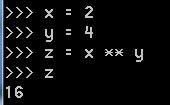
- //,取整除,你可以理解为向下取整,看图:
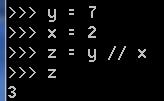
2、比较运算:
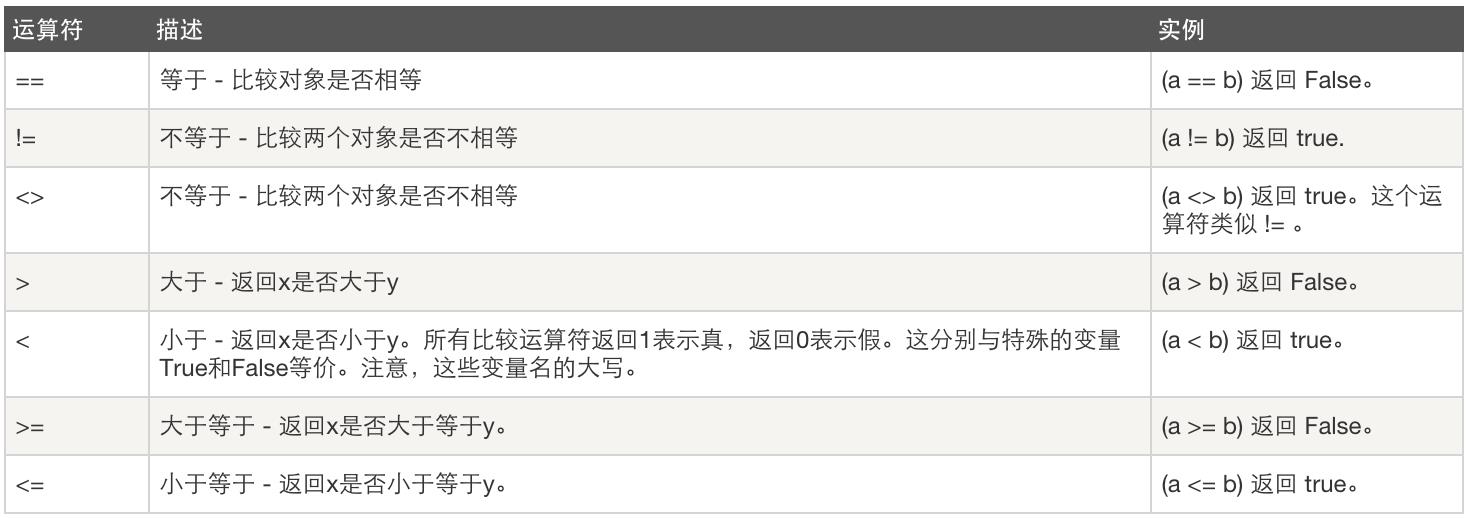
注意:当为一个等号时,多为赋值,两个等号为比较,另外不等于常用是!=
3、赋值运算:
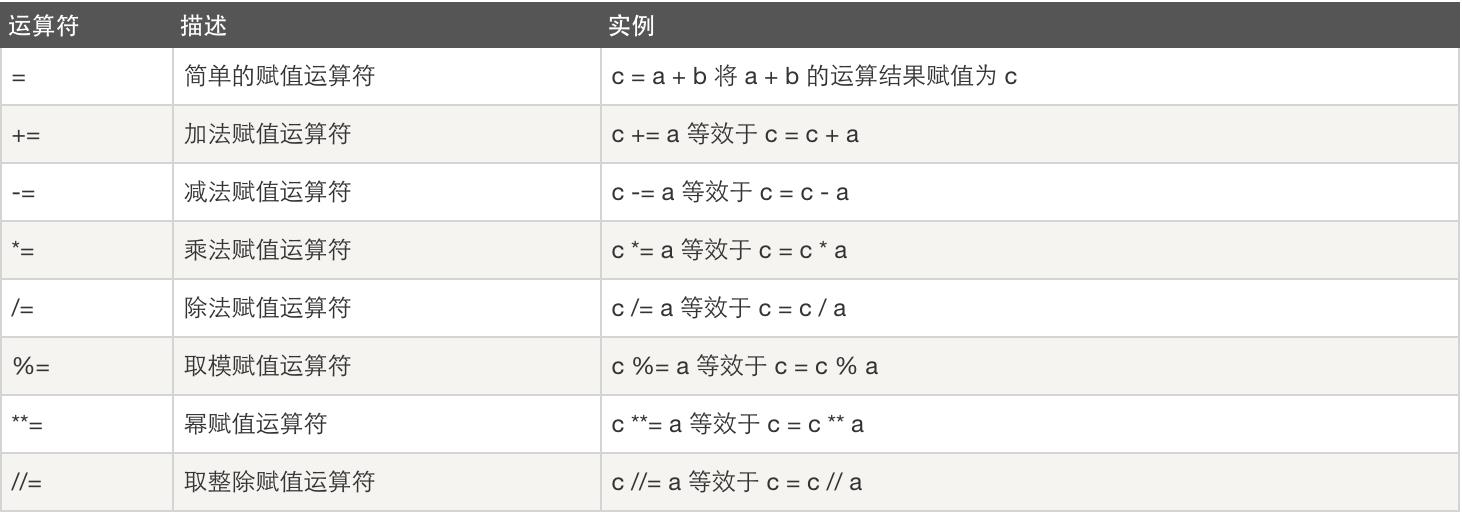
4、逻辑运算:

逻辑运算符里,and和or好理解,那我就讲一下not:这家伙就是唱反调的--看图
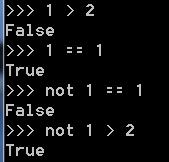
5、成员运算:

成员运算符,从字面上意思去理解,问谁是不是某组织里的一份子,好!例子说话
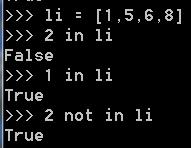
二.基本数据类型
- 对象是基于类创建的,对象的功能或方法都在类里
- python里的基本数据类型--int,str,list,dict,tuple都是类
- 类是抽象的,对象则是具体的,所以只有类-对象化,才可使用类的方法
- 查看类或对象的所有方法:dir(对象)--查看功能, help(类)--详细, ctrl + 左键(pycharm里)
1.int(整型)
- 在32位机器上,整数的位数为32位,取值范围为-2**31~2**31-1,即-2147483648~2147483647
- 在64位系统上,整数的位数为64位,取值范围为-2**63~2**63-1,即-9223372036854775808~922337203685477580
class int(object): """ int(x=0) -> int or long int(x, base=10) -> int or long Convert a number or string to an integer, or return 0 if no arguments are given. If x is floating point, the conversion truncates towards zero. If x is outside the integer range, the function returns a long instead. If x is not a number or if base is given, then x must be a string or Unicode object representing an integer literal in the given base. The literal can be preceded by \'+\' or \'-\' and be surrounded by whitespace. The base defaults to 10. Valid bases are 0 and 2-36. Base 0 means to interpret the base from the string as an integer literal. >>> int(\'0b100\', base=0) 4 """ def bit_length(self): """ 返回表示该数字的时占用的最少位数 """ """ int.bit_length() -> int Number of bits necessary to represent self in binary. >>> bin(37) \'0b100101\' >>> (37).bit_length() 6 """ return 0 def conjugate(self, *args, **kwargs): # real signature unknown """ 返回该复数的共轭复数 """ """ Returns self, the complex conjugate of any int. """ pass def __abs__(self): """ 返回绝对值 """ """ x.__abs__() <==> abs(x) """ pass def __add__(self, y): """ x.__add__(y) <==> x+y """ pass def __and__(self, y): """ x.__and__(y) <==> x&y """ pass def __cmp__(self, y): """ 比较两个数大小 """ """ x.__cmp__(y) <==> cmp(x,y) """ pass def __coerce__(self, y): """ 强制生成一个元组 """ """ x.__coerce__(y) <==> coerce(x, y) """ pass def __divmod__(self, y): """ 相除,得到商和余数组成的元组 """ """ x.__divmod__(y) <==> divmod(x, y) """ pass def __div__(self, y): """ x.__div__(y) <==> x/y """ pass def __float__(self): """ 转换为浮点类型 """ """ x.__float__() <==> float(x) """ pass def __floordiv__(self, y): """ x.__floordiv__(y) <==> x//y """ pass def __format__(self, *args, **kwargs): # real signature unknown pass def __getattribute__(self, name): """ x.__getattribute__(\'name\') <==> x.name """ pass def __getnewargs__(self, *args, **kwargs): # real signature unknown """ 内部调用 __new__方法或创建对象时传入参数使用 """ pass def __hash__(self): """如果对象object为哈希表类型,返回对象object的哈希值。哈希值为整数。在字典查找中,哈希值用于快速比较字典的键。两个数值如果相等,则哈希值也相等。""" """ x.__hash__() <==> hash(x) """ pass def __hex__(self): """ 返回当前数的 十六进制 表示 """ """ x.__hex__() <==> hex(x) """ pass def __index__(self): """ 用于切片,数字无意义 """ """ x[y:z] <==> x[y.__index__():z.__index__()] """ pass def __init__(self, x, base=10): # known special case of int.__init__ """ 构造方法,执行 x = 123 或 x = int(10) 时,自动调用,暂时忽略 """ """ int(x=0) -> int or long int(x, base=10) -> int or long Convert a number or string to an integer, or return 0 if no arguments are given. If x is floating point, the conversion truncates towards zero. If x is outside the integer range, the function returns a long instead. If x is not a number or if base is given, then x must be a string or Unicode object representing an integer literal in the given base. The literal can be preceded by \'+\' or \'-\' and be surrounded by whitespace. The base defaults to 10. Valid bases are 0 and 2-36. Base 0 means to interpret the base from the string as an integer literal. >>> int(\'0b100\', base=0) 4 # (copied from class doc) """ pass def __int__(self): """ 转换为整数 """ """ x.__int__() <==> int(x) """ pass def __invert__(self): """ x.__invert__() <==> ~x """ pass def __long__(self): """ 转换为长整数 """ """ x.__long__() <==> long(x) """ pass def __lshift__(self, y): """ x.__lshift__(y) <==> x<<y """ pass def __mod__(self, y): """ x.__mod__(y) <==> x%y """ pass def __mul__(self, y): """ x.__mul__(y) <==> x*y """ pass def __neg__(self): """ x.__neg__() <==> -x """ pass @staticmethod # known case of __new__ def __new__(S, *more): """ T.__new__(S, ...) -> a new object with type S, a subtype of T """ pass def __nonzero__(self): """ x.__nonzero__() <==> x != 0 """ pass def __oct__(self): """ 返回改值的 八进制 表示 """ """ x.__oct__() <==> oct(x) """ pass def __or__(self, y): """ x.__or__(y) <==> x|y """ pass def __pos__(self): """ x.__pos__() <==> +x """ pass def __pow__(self, y, z=None): """ 幂,次方 """ """ x.__pow__(y[, z]) <==> pow(x, y[, z]) """ pass def __radd__(self, y): """ x.__radd__(y) <==> y+x """ pass def __rand__(self, y): """ x.__rand__(y) <==> y&x """ pass def __rdivmod__(self, y): """ x.__rdivmod__(y) <==> divmod(y, x) """ pass def __rdiv__(self, y): """ x.__rdiv__(y) <==> y/x """ pass def __repr__(self): """转化为解释器可读取的形式 """ """ x.__repr__() <==> repr(x) """ pass def __str__(self): """转换为人阅读的形式,如果没有适于人阅读的解释形式的话,则返回解释器课阅读的形式""" """ x.__str__() <==> str(x) """ pass def __rfloordiv__(self, y): """ x.__rfloordiv__(y) <==> y//x """ pass def __rlshift__(self, y): """ x.__rlshift__(y) <==> y<<x """ pass def __rmod__(self, y): """ x.__rmod__(y) <==> y%x """ pass def __rmul__(self, y): """ x.__rmul__(y) <==> y*x """ pass def __ror__(self, y): """ x.__ror__(y) <==> y|x """ pass def __rpow__(self, x, z=None): """ y.__rpow__(x[, z]) <==> pow(x, y[, z]) """ pass def __rrshift__(self, y): """ x.__rrshift__(y) <==> y>>x """ pass def __rshift__(self, y): """ x.__rshift__(y) <==> x>>y """ pass def __rsub__(self, y): """ x.__rsub__(y) <==> y-x """ pass def __rtruediv__(self, y): """ x.__rtruediv__(y) <==> y/x """ pass def __rxor__(self, y): """ x.__rxor__(y) <==> y^x """ pass def __sub__(self, y): """ x.__sub__(y) <==> x-y """ pass def __truediv__(self, y): """ x.__truediv__(y) <==> x/y """ pass def __trunc__(self, *args, **kwargs): """ 返回数值被截取为整形的值,在整形中无意义 """ pass def __xor__(self, y): """ x.__xor__(y) <==> x^y """ pass denominator = property(lambda self: object(), lambda self, v: None, lambda self: None) # default """ 分母 = 1 """ """the denominator of a rational number in lowest terms""" imag = property(lambda self: object(), lambda self, v: None, lambda self: None) # default """ 虚数,无意义 """ """the imaginary part of a complex number""" numerator = property(lambda self: object(), lambda self, v: None, lambda self: None) # default """ 分子 = 数字大小 """ """the numerator of a rational number in lowest terms""" real = property(lambda self: object(), lambda self, v: None, lambda self: None) # default """ 实属,无意义 """ """the real part of a complex number""" - 你不用担心数值超过int的长度,python会自动转化long(长整)

class int(object): """ int(x=0) -> int or long int(x, base=10) -> int or long Convert a number or string to an integer, or return 0 if no arguments are given. If x is floating point, the conversion truncates towards zero. If x is outside the integer range, the function returns a long instead. If x is not a number or if base is given, then x must be a string or Unicode object representing an integer literal in the given base. The literal can be preceded by \'+\' or \'-\' and be surrounded by whitespace. The base defaults to 10. Valid bases are 0 and 2-36. Base 0 means to interpret the base from the string as an integer literal. >>> int(\'0b100\', base=0) 4 """ def bit_length(self): """ 返回表示该数字的时占用的最少位数 """ """ int.bit_length() -> int Number of bits necessary to represent self in binary. >>> bin(37) \'0b100101\' >>> (37).bit_length() 6 """ return 0 def conjugate(self, *args, **kwargs): # real signature unknown """ 返回该复数的共轭复数 """ """ Returns self, the complex conjugate of any int. """ pass def __abs__(self): """ 返回绝对值 """ """ x.__abs__() <==> abs(x) """ pass def __add__(self, y): """ x.__add__(y) <==> x+y """ pass def __and__(self, y): """ x.__and__(y) <==> x&y """ pass def __cmp__(self, y): """ 比较两个数大小 """ """ x.__cmp__(y) <==> cmp(x,y) """ pass def __coerce__(self, y): """ 强制生成一个元组 """ """ x.__coerce__(y) <==> coerce(x, y) """ pass def __divmod__(self, y): """ 相除,得到商和余数组成的元组 """ """ x.__divmod__(y) <==> divmod(x, y) """ pass def __div__(self, y): """ x.__div__(y) <==> x/y """ pass def __float__(self): """ 转换为浮点类型 """ """ x.__float__() <==> float(x) """ pass def __floordiv__(self, y): """ x.__floordiv__(y) <==> x//y """ pass def __format__(self, *args, **kwargs): # real signature unknown pass def __getattribute__(self, name): """ x.__getattribute__(\'name\') <==> x.name """ pass def __getnewargs__(self, *args, **kwargs): # real signature unknown """ 内部调用 __new__方法或创建对象时传入参数使用 """ pass def __hash__(self): """如果对象object为哈希表类型,返回对象object的哈希值。哈希值为整数。在字典查找中,哈希值用于快速比较字典的键。两个数值如果相等,则哈希值也相等。""" """ x.__hash__() <==> hash(x) """ pass def __hex__(self): """ 返回当前数的 十六进制 表示 """ """ x.__hex__() <==> hex(x) """ pass def __index__(self): """ 用于切片,数字无意义 """ """ x[y:z] <==> x[y.__index__():z.__index__()] """ pass def __init__(self, x, base=10): # known special case of int.__init__ """ 构造方法,执行 x = 123 或 x = int(10) 时,自动调用,暂时忽略 """ """ int(x=0) -> int or long int(x, base=10) -> int or long Convert a number or string to an integer, or return 0 if no arguments are given. If x is floating point, the conversion truncates towards zero. If x is outside the integer range, the function returns a long instead. If x is not a number or if base is given, then x must be a string or Unicode object representing an integer literal in the given base. The literal can be preceded by \'+\' or \'-\' and be surrounded by whitespace. The base defaults to 10. Valid bases are 0 and 2-36. Base 0 means to interpret the base from the string as an integer literal. >>> int(\'0b100\', base=0) 4 # (copied from class doc) """ pass def __int__(self): """ 转换为整数 """ """ x.__int__() <==> int(x) """ pass def __invert__(self): """ x.__invert__() <==> ~x """ pass def __long__(self): """ 转换为长整数 """ """ x.__long__() <==> long(x) """ pass def __lshift__(self, y): """ x.__lshift__(y) <==> x<<y """ pass def __mod__(self, y): """ x.__mod__(y) <==> x%y """ pass def __mul__(self, y): """ x.__mul__(y) <==> x*y """ pass def __neg__(self): """ x.__neg__() <==> -x """ pass @staticmethod # known case of __new__ def __new__(S, *more): """ T.__new__(S, ...) -> a new object with type S, a subtype of T """ pass def __nonzero__(self): """ x.__nonzero__() <==> x != 0 """ pass def __oct__(self): """ 返回改值的 八进制 表示 """ """ x.__oct__() <==> oct(x) """ pass def __or__(self, y): """ x.__or__(y) <==> x|y """ pass def __pos__(self): """ x.__pos__() <==> +x """ pass def __pow__(self, y, z=None): """ 幂,次方 """ """ x.__pow__(y[, z]) <==> pow(x, y[, z]) """ pass def __radd__(self, y): """ x.__radd__(y) <==> y+x """ pass def __rand__(self, y): """ x.__rand__(y) <==> y&x """ pass def __rdivmod__(self, y): """ x.__rdivmod__(y) <==> divmod(y, x) """ pass def __rdiv__(self, y): """ x.__rdiv__(y) <==> y/x """ pass def __repr__(self): """转化为解释器可读取的形式 """ """ x.__repr__() <==> repr(x) """ pass def __str__(self): """转换为人阅读的形式,如果没有适于人阅读的解释形式的话,则返回解释器课阅读的形式""" """ x.__str__() <==> str(x) """ pass def __rfloordiv__(self, y): """ x.__rfloordiv__(y) <==> y//x """ pass def __rlshift__(self, y): """ x.__rlshift__(y) <==> y<<x """ pass def __rmod__(self, y): """ x.__rmod__(y) <==> y%x """ pass def __rmul__(self, y): """ x.__rmul__(y) <==> y*x """ pass def __ror__(self, y): """ x.__ror__(y) <==> y|x """ pass def __rpow__(self, x, z=None): """ y.__rpow__(x[, z]) <==> pow(x, y[, z]) """ pass def __rrshift__(self, y): """ x.__rrshift__(y) <==> y>>x """ pass def __rshift__(self, y): """ x.__rshift__(y) <==> x>>y """ pass def __rsub__(self, y): """ x.__rsub__(y) <==> y-x """ pass def __rtruediv__(self, y): """ x.__rtruediv__(y) <==> y/x """ pass def __rxor__(self, y): """ x.__rxor__(y) <==> y^x """ pass def __sub__(self, y): """ x.__sub__(y) <==> x-y """ pass def __truediv__(self, y): """ x.__truediv__(y) <==> x/y """ pass def __trunc__(self, *args, **kwargs): """ 返回数值被截取为整形的值,在整形中无意义 """ pass def __xor__(self, y): """ x.__xor__(y) <==> x^y """ pass denominator = property(lambda self: object(), lambda self, v: None, lambda self: None) # default """ 分母 = 1 """ """the denominator of a rational number in lowest terms""" imag = property(lambda self: object(), lambda self, v: None, lambda self: None) # default """ 虚数,无意义 """ """the imaginary part of a complex number""" numerator = property(lambda self: object(), lambda self, v: None, lambda self: None) # default """ 分子 = 数字大小 """ """the numerator of a rational number in lowest terms
